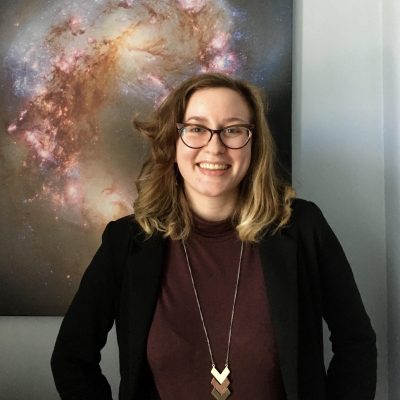Student Spotlight: Stella Ocker

May 24, 2021
Stella Ocker is a doctoral candidate in astronomy and space sciences from San Anselmo, California. After attending Oberlin College in Ohio as an undergraduate, she chose to pursue further study at Cornell due to the intellectually rigorous research and supportive environment offered.
What is your area of research and why is it important?
I study the interstellar medium (ISM), all of the gas, dust, and particles that fill the space between stars. Most astrophysical signals travel through the ISM before arriving at our detectors, so understanding the ISM is vital to studying a wide variety of astrophysical phenomena. My dissertation focuses on how complementary studies of the ISM with Voyager, pulsars (rotating neutron stars), and fast radio bursts can reveal the structure and properties of the ISM in our nearby interstellar environment, the Milky Way, and other galaxies.
What are the larger implications of this research?
The understanding we gain of the ISM from neutron stars, fast radio bursts, and Voyager allows us to use them for a wide range of powerful astrophysical applications. Pulsars can be used to measure gravitational waves, test general relativity, and explore the state of the densest matter in the universe. Doing so, however, requires deep knowledge of how the ISM interferes with the pulsar signals we ultimately observe. This same knowledge must also be applied to fast radio bursts, whose physical origins remain a mystery that our field is racing to solve.
You were lead author on “Persistent plasma waves in interstellar space detected by Voyager 1.” What do you imagine are the larger implications of this study?
This study allows us to make the longest steady measurement of the density of interstellar space along Voyager 1’s journey. Our detection suggests that Voyager, and possibly even a future interstellar mission, can almost continuously measure the density of interstellar space. With this knowledge we can learn about the structure of the sun’s local interstellar environment and how the solar wind and interstellar medium interact and shape our heliosphere, the protective bubble created by the solar wind pushing out against the interstellar medium.
This research has been picked up by dozens of other news sources. How do you feel knowing your research is making such an impact?
I’m delighted to see a large amount of interest in our latest research from Voyager. The Voyager mission has an incredible legacy and is really pushing the limits of interstellar exploration, even after over 40 years of space travel. I’m happy to have played even a small part in continuing to share that legacy with the world.
How did you get involved with this research and what drew you to it?
Last year my advisors and I won a NASA Outer Heliosphere Guest Investigator grant to join the Voyager Interstellar Mission. I jumped at this opportunity to work with Voyager because it offers really unique, direct sampling of the interstellar medium. I was first drawn to research on the interstellar medium as an undergraduate student, thanks to the enthusiasm and encouragement of my advisor at Oberlin, Prof. Dan Stinebring. He introduced me to an international community of scientists whose passion for the field really piqued my curiosity.
What are your hobbies or interests outside of your research or scholarship?
I’m an avid bookworm (especially sci-fi, fantasy, and Victorian literature). I love listening to podcasts and frequently bore my friends with the latest strange facts I’ve heard on them. I also love to crochet and to go on an easy jog on a warm day. This past year, I started taking Hebrew classes at Cornell so that I can speak with my mother in her native language.
Why did you choose Cornell to pursue your degree?
I chose the field of astronomy at Cornell because its program offers both world-class, intellectually rigorous research while also fostering a supportive environment that helps its students to grow and achieve their personal goals. Before coming to Cornell I received a lot of encouragement from previous Cornell grads who made me confident that Cornell, and Ithaca more broadly, would be a fun place to live and work while also finding my roots as a researcher and a scientist.
